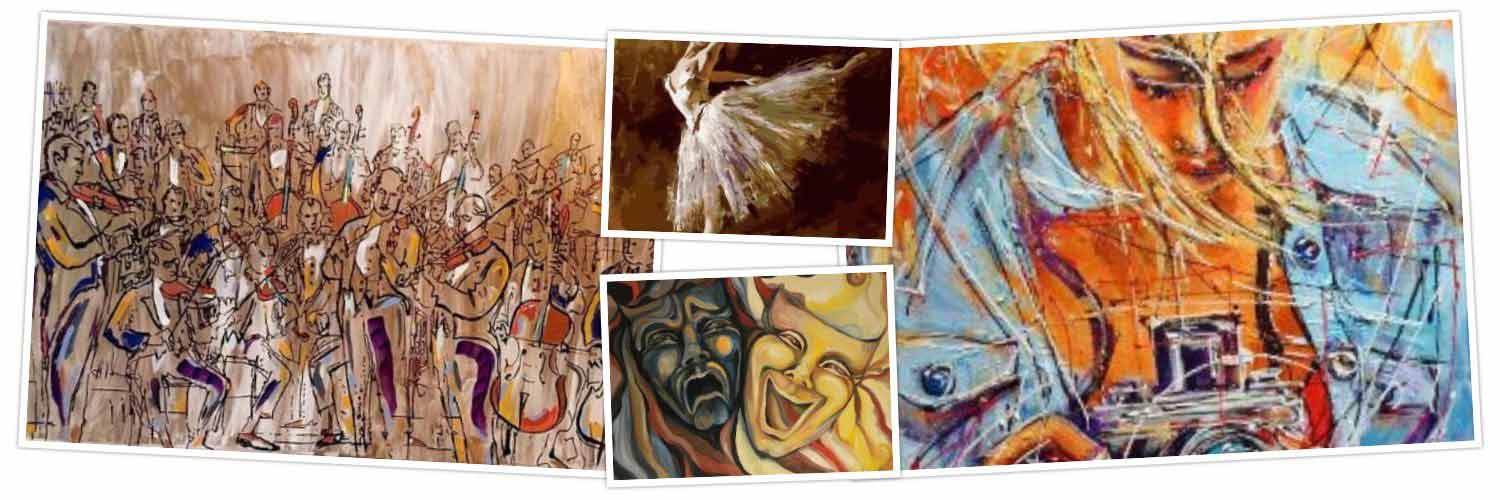“Fashion Nirvana” Looks at Art of Fashion Design
By JASMINA WELLINGHOFF, Editor —
The work of fashion designers has been glamorized by glossy magazines and shown on runways in Paris, Milan and New York, but we seldom associate it with art museums. That is changing, however. In search of new audiences and in recognition of the creativity that goes into fashion design, museums in both Europe and America have started looking at fashion with curiosity and a new appreciation.
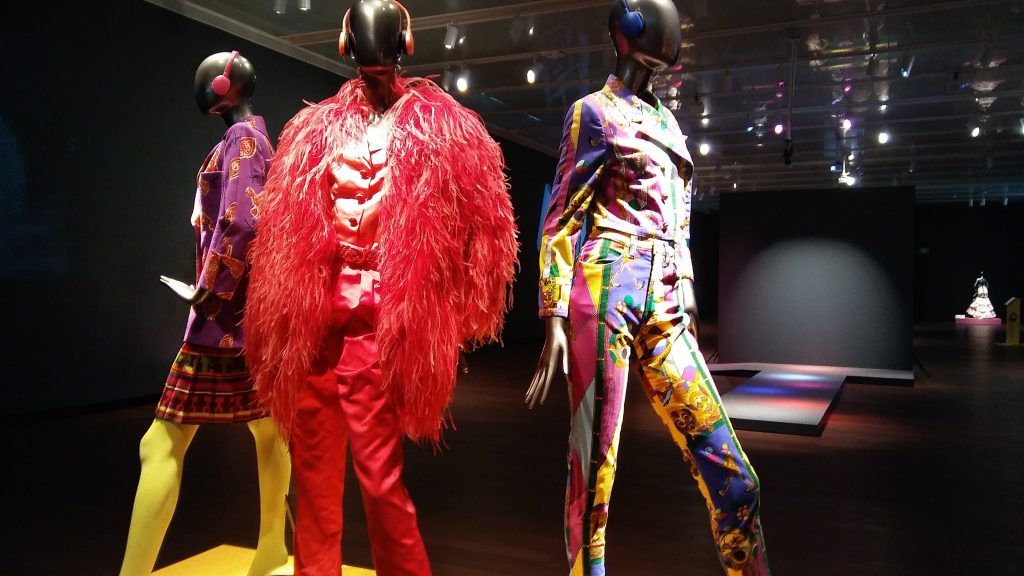
In recent years, major museums, such as the Victoria and Albert Museum in London, the Montreal Museum of Art and the Houston Museum of Art mounted remarkable exhibitions devoted to great designers such as, Christian Dior, Thierry Mugler and Oscar de La Renta, respectively.
And now the McNay Art Museum has joined the trend with its own original exhibit, Fashion Nirvana: Runway to Everyday, which focuses on the designers and video artists of the 1990s, a decade described as one “of great hope and freedom” following the Cold War and the Fall of the Berlin Wall. It opened Jan. 30 and will be on view through May 17. The show fits well into the McNay’s strategy of expanding the boundaries of what is considered art.
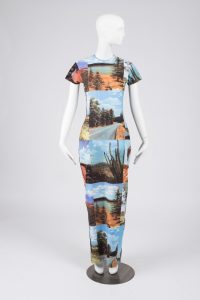
(courtesy photo)
“The McNay is known for innovation,” said the museum’s director and CEO Richard Aste. “That was established by our founder in the 1920s, a woman (Marion Koogler McNay) who created a collection unlike any other in this part of the world at that time. This exhibition is part of continuing innovation by being the first exhibition in the world to look back at the 1990s through the lens of fashion and video arts. The 90s were a fearless decade when artists took a lot of risks and went where they had never gone before.”
The exhibit features more than 60 garments by a range of designers, including Dior, Carolina Herrera, Isaac Mizrahi, Oscar de La Renta, Gianni Versace, John Galliano, Todd Oldham, Vivienne Tam and others.
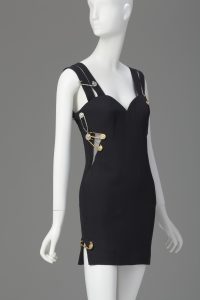
Perhaps not surprisingly, the lead curator is a woman, Kate Carey, head of education at the McNay, who was helped by three other women in putting the show together.
“I love fashion and I have an interest in fashion,” said Carey. “My former colleague Jackie Edwards and I started brain storming about a year ago about having an exhibit of fashion design. It’s a great time for it, because many of our exhibitions have been pushing boundaries. Last year there were cars from the 1950s in the gallery!”
As to why they picked the 1990s, Carey explained that it was at least in part a personal choice. “I was in 6th grade in 1989 and graduated from college in 2000. Those were my formative years and also for Jackie.”
Though she did not wear fancy designer clothes, she did wear garments that are similar to the ones on view, like a T-shirt dress, for instance. A mannequin wearing Todd Oldham’s T-shirt dress in polyester knit was only a few yards away from where she was standing as we talked. “Tank tops, T-shirts, boots, those were my 90s’ clothes,” said the curator. “In the 90s there were a lot of designers who looked at street wear and incorporated what they saw in their design, making it high fashion.”
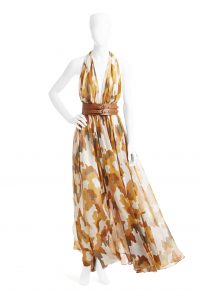
(courtesy photo)
Do the designers in Fashion Nirvana have anything in common besides the fact that they were all active in the 1990s? We wondered.
“A lot of them were looking beyond traditional materials, even beyond the traditional silhouette,” explained Carey. “The haute couture brands were fading in the 1990s and that’s why some of these emerging designers got their chance. They knew how to create out of very little. That said, there are still some showstoppers in here.”
Her personal favorite is an Azzedine Alaia ensemble consisting of a checkered dress and a motorcycle-type jacket. “I would love to own that, and who wouldn’t want to have an Alexander McQueen suit?!” And that’s another thing that connects the various 90s’ designers, she noted, the fact that so much of the clothing could be worm today without looking dated.
Most of the clothes come from the Texas Fashion Collection at the North Texas University that the women visited to research their choices. Other items were borrowed from UT Austin’s Historic Textile and Apparel Collection and from the Phoenix Art Museum. Ultimately, they decided to present the clothes in four sections: Conceal & Reveal; Less is More & More is More; Legends & Young Bloods; and Culture & Subculture.
“The first section is looking at how many designers in the 90s started to make more revealing clothing that focused on sex appeal,” said co-curator Lauren Thompson, an assistant curator at the McNay. “So, you have designers like Tom Ford for Gucci, who was known for his provocative ad campaigns and also for deeply plunging necklines. Here we also have Dolce & Gabbana who used lingerie as inspiration for their garments. In the 90s, they also designed costumes for one of Madonna’s tours.”
Also displayed in that section is a 1994 little dress by Gianni Versace that pretends to be held together by large safety pins,” and an outfit by Bliss Blass. The “conceal” group is represented by Vera Wang who added jackets to sleeveless gowns.

The next section showcases a couple of examples of minimalism practiced by Calvin Klein and Wang, which contrast with More is More items, featuring voluminous dimensions as well as bold colors and patterns, most obviously embodied in an Oscar de La Renta over-the-top red feather-jacket that you can’t miss. “It definitely makes a statement,” noted Thompson. Next to it is a Versace suit fit for an elegant clown.
Moving further into the gallery, you’ll encounter “fashion legends,” with more examples of the de La Renta’s elegant gowns and Geoffrey Beene’s and Gianfranco Ferre’s creations, as well as up-and-coming designers of the period, like Galliano, Tom Ford and Alexander McQueen, who ended up reshaping the output of established couture houses that employed them. It’s interesting to be reminded that even de La Renta went to work for another couture brand, Balmain, when he was in his 60s.
The whimsical and controversial work of Chinese-born Vivienne Tam is found in the last Culture & Subculture area, including a dress stamped with portraits of Mao Zedong. Victor Costa, Isaac Mizrahi, Karl Lagerfeld, Marc Jacobs and Todd Oldham are also there.
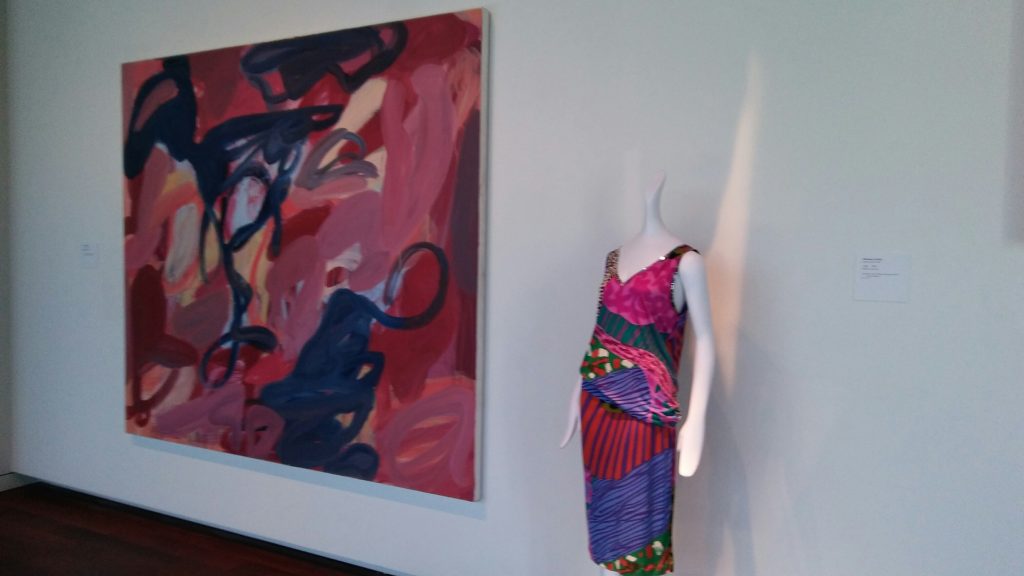
Jasmina Wellinghoff)
But don’t miss the part of Fashion Nirvana housed in the lower, sculpture gallery where natural light floods the interior and lifts the spirits. Here, clothed mannequins are paired with visual art works from the McNay collection that seem to resonate in color and feel with the garments. This is especially true for the multicolored duos like Oldham’s Cocktail Dress and Skirt made of bright-colored silk ribbon, and its wall partner, 1-25, consisting of a large panel divided into 25 squares of different colors. We also liked the pairing of a Missoni ensemble with Melissa Meyer’s 1990 painting Cauchemar, an abstract yet eloquent canvas of swirling strokes of magenta, rose and dusty blue, that harmonizes beautifully with the colors and soft folds of the silk jersey outfit.
Fashion Nirvana also includes artist-made videos mentioned at the beginning of this article, but it takes time and concentration to watch them. So, we left that part for our second visit. In fact, the entire show merits a second look.
Fashion Nirvana: Runway to Everyday, McNay Art Museum, 6000 N. New Braunfels, through may 17; Admission charged; 210-824-5368.
Special Events include: Evening for Educators: Be Kind. Rewind. Feb.6, 5-8 p.m.; 90s Throwback Night: Grunge or Glam, Feb. 27, 6:30 p.m.; GET REEL: Clueless, March 19, 6:30 p.m.; Teen Night: Art After Dark, March 27, 7-10 p.m.; Spring Break Free Family Night, March 12, 4-9 p.m.; Luncheon: Mizrahi at the McNay, May 7, 11:30 a.m., a fundraising event.
